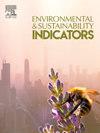Higher transpiration in plant invasive species impacts soil water
IF 5.4
Q1 ENVIRONMENTAL SCIENCES
引用次数: 0
Abstract
Studies on plant invasives are largely focused on their impacts on plant community structure, native biodiversity, ecosystem services, and economy, but their ecosystem effects as high water-spenders are underestimated. Here, we report contrasting results in transpiration volumes in Prosopis juliflora (Sw.) DC (Prosopis juliflora), a widespread invasive alien, its native non-invasive congener, Prosopis cineraria (L.) Druce (P. cineraria), and an unrelated co-occurring native, Azadirachta indica A. Juss. (Azadirachta indica) at 3 sites spread across North and South between 200 and 550 m elevations in India. Our results demonstrate that P. juliflora shows higher transpiration than the native P. cineraria and A. indica at all the three investigated sites. The transpiration volumes of P. juliflora were 2.9–8 times higher than P. cineraria and A. indica at Jodhpur, and 6–11 times higher than A. indica at New Delhi and Hyderabad, respectively. The soil moisture content in the rhizosphere of P. juliflora dominated sites was 2–5 times lower than that of P. cineraria and A. indica dominated sites during summer. The results clearly demonstrate that invasive species transpire more water than the natives that consequently leads to decrease in soil moisture availability. Our investigations provide a strong rationale for managing the alien invasive P. juliflora and restoring native vegetation. Controlling the invasive species is particularly important for the regions with prolonged hot summers and freshwater shortages, such as tropical Asia, Middle East and tropical Africa, where P. juliflora has invaded vast areas.
植物入侵物种蒸腾作用增大,影响土壤水分
植物入侵的研究主要集中在其对植物群落结构、本地生物多样性、生态系统服务和经济的影响上,但其对生态系统的高耗水效应被低估。在这里,我们报告了黄豆(Sw.)蒸腾量的对比结果。DC (Prosopis juliflora),一种广泛入侵的外来物种,其原生非入侵的同系物,Prosopis cineraria (L.)(P. cineraria)和一种不相关的共生原生植物Azadirachta indica A. Juss。(Azadirachta indica)分布在印度海拔200米至550米之间的南北三个地点。结果表明,在所有3个调查地点,黄花假单胞菌的蒸腾作用均高于当地的灰孢假单胞菌和印度假单胞菌。在焦特布尔,朱丽草木的蒸腾量分别是梧桐和籼稻的2.9 ~ 8倍,新德里和海德拉巴分别是籼稻的6 ~ 11倍。夏季,黄花假豆优势地根际土壤水分含量比灰麦假豆和籼稻优势地低2 ~ 5倍。结果清楚地表明,入侵物种比本地物种蒸腾更多的水,从而导致土壤水分有效性降低。我们的研究结果为管理外来入侵的胡杨和恢复本地植被提供了强有力的理论依据。控制入侵物种对于夏季长时间炎热和淡水短缺的地区尤为重要,如热带亚洲、中东和热带非洲,在这些地区,黄花紫檀已经入侵了大片地区。
本文章由计算机程序翻译,如有差异,请以英文原文为准。
求助全文
约1分钟内获得全文
求助全文
来源期刊

Environmental and Sustainability Indicators
Environmental Science-Environmental Science (miscellaneous)
CiteScore
7.80
自引率
2.30%
发文量
49
审稿时长
57 days
 求助内容:
求助内容: 应助结果提醒方式:
应助结果提醒方式:


